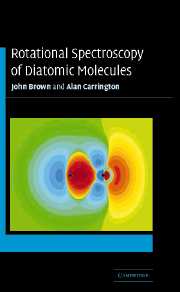Book contents
- Frontmatter
- Contents
- Preface
- Summary of notation
- Figure acknowledgements
- 1 General introduction
- 2 The separation of nuclear and electronic motion
- 3 The electronic Hamiltonian
- 4 Interactions arising from nuclear magnetic and electric moments
- 5 Angular momentum theory and spherical tensor algebra
- 6 Electronic and vibrational states
- 7 Derivation of the effective Hamiltonian
- 8 Molecular beam magnetic and electric resonance
- 9 Microwave and far-infrared magnetic resonance
- 10 Pure rotational spectroscopy
- 11 Double resonance spectroscopy
- General appendices
- Author index
- Subject index
- References
3 - The electronic Hamiltonian
Published online by Cambridge University Press: 17 December 2010
- Frontmatter
- Contents
- Preface
- Summary of notation
- Figure acknowledgements
- 1 General introduction
- 2 The separation of nuclear and electronic motion
- 3 The electronic Hamiltonian
- 4 Interactions arising from nuclear magnetic and electric moments
- 5 Angular momentum theory and spherical tensor algebra
- 6 Electronic and vibrational states
- 7 Derivation of the effective Hamiltonian
- 8 Molecular beam magnetic and electric resonance
- 9 Microwave and far-infrared magnetic resonance
- 10 Pure rotational spectroscopy
- 11 Double resonance spectroscopy
- General appendices
- Author index
- Subject index
- References
Summary
The Dirac equation
The analysis of molecular spectra requires the choice of an effective Hamiltonian, an appropriate basis set, and calculation of the eigenvalues and eigenvectors. The effective Hamiltonian will contain molecular parameters whose values are to be determined from the spectral analysis. The theory underlying these parameters requires detailed consideration of the fundamental electronic Hamiltonian, and the effects of applied magnetic or electrostatic fields. The additional complications arising from the presence of nuclear spins are often extremely important in high-resolution spectra, and we shall describe the theory underlying nuclear spin hyperfine interactions in chapter 4. The construction of effective Hamiltonians will then be described in chapter 7.
In this section we outline the steps which lead to a wave equation for the electron satisfying the requirements of the special theory of relativity. This equation was first proposed by Dirac, and investigation of its eigenvalues and eigenfunctions, particularly in the presence of an electromagnetic field, leads naturally to the property of electron spin and its associated magnetic moment. Our procedure is to start from classical mechanics, and then to convert the equations to quantum mechanical form; we obtain a relativistically-correct second-order wave equation known as the Klein–Gordon equation. Dirac's wave equation is linear in the momentum operator and is so constructed that its eigenvalues and eigenfunctions are also solutions of the Klein–Gordon equation.
- Type
- Chapter
- Information
- Rotational Spectroscopy of Diatomic Molecules , pp. 73 - 122Publisher: Cambridge University PressPrint publication year: 2003

